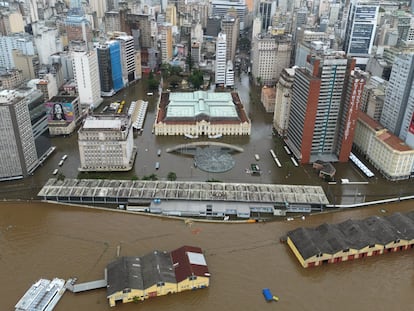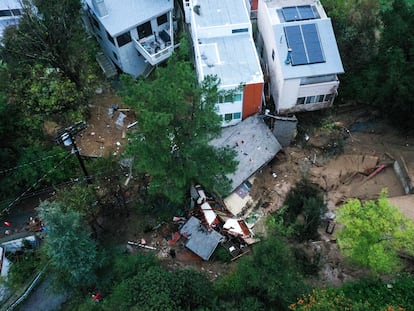‘Alberto’ makes landfall in Mexico after tropical storm floods southern Texas
The first named weather event of the hurricane season is bringing strong winds, heavy rainfall and flooding along the coasts of Texas and Mexico

Tropical Storm Alberto formed Wednesday in the southwestern Gulf of Mexico, the first named storm of what is forecast to be a busy hurricane season. Authorities in Mexico reported three deaths from its rains.
Alberto, which is bringing strong winds, heavy rainfall and some flooding along the coasts of Texas and Mexico, made landfall in northern Mexico early Thursday.
“The heavy rainfall and the water, as usual, is the biggest story in tropical storms,” said Michael Brennan, director of the U. S. National Oceanic and Atmospheric Administration (NOAA)’s National Hurricane Center.
Civil protection authorities in the northern state of Nuevo León said one man died in the La Silla river in the city of Monterrey, the state capital. They also said that two minors died from electric shocks in the municipality of Allende. Local media reported that the minors were riding a bicycle in the rain.
The National Hurricane Center said late Wednesday that Alberto was located about 135 miles (220 kilometers) east of Tampico, Mexico, and about 320 miles (510 kilometers) south-southeast of Brownsville, Texas, with maximum sustained winds of 50 mph (85 kph). The storm was moving west at nine miles per hour.
The center of the storm was expected to reach the northeastern coast of Mexico south of the mouth of the Rio Grande by Thursday morning.
As much as 5 inches (13 centimeters) to 10 inches (25 centimeters) of rain was expected in some areas along the Texas coast, with even higher isolated totals possible, Brennan said. He said some higher locations in Mexico could see as much as 20 inches (50 centimeters) of rain, which could result in mudslides and flash flooding, especially in the states of Tamaulipas, Coahuila and Nuevo León.
Many residents were excited about the prospect of heavy showers, as Tamaulipas and most of Mexico has been dealing with extreme droughts.
“We have been needing this water that we’re now getting, thank God. Let’s hope that we only get water,” said Blanca Coronel Moral, a resident of Tampico. “Our lagoon, which gives us drinking water, is completely dry.”
Flooding in Texas
Tropical storm warnings were in effect from the Texas coast at San Luis Pass southward to the mouth of the Rio Grande and from the northeastern coast of Mexico south of the mouth of the Rio Grande to Tecolutla. Extensive coastal flooding has been reported at beaches and coastlines in southern Texas.
“Rapid weakening is expected once the center moves inland, and Alberto is likely to dissipate over Mexico” on Thursday, the center said.
Potential Tropical Cyclone One is now Tropical Storm Alberto! Extensive coastal flooding has been reported at area beaches, coastlines. No changes to existing warnings. #txwx #houwx pic.twitter.com/oBHDJDiyfo
— NWS Houston (@NWSHouston) June 19, 2024
The U.S. National Weather Service said the main hazard for southern coastal Texas is flooding from excess rain. On Wednesday, the NWS said, there is “a high probability” of flash flooding in southern coastal Texas. Tornadoes or waterspouts are possible.
Areas along the Texas coast were seeing some road flooding and dangerous rip currents Wednesday. “We’ve seen a few brief spin-ups and some waterspouts out there,” said Tyler Castillo, a meteorologist with the National Weather Service office in Corpus Christi.
Tim Cady, a meteorologist with the National Weather Service in Houston, said they’ll be keeping an eye on coastal flooding as high tide approaches Thursday morning.
“When we have these strong onshore winds combined with the high tide, that can result in coastal inundation, particularly in our lower-lying coastal areas,” Cady said.
NOAA predicts the hurricane season that began June 1 and runs through November 30 is likely to be well above average, with between 17 and 25 named storms. The forecast predicts as many as 13 hurricanes and four major hurricanes.
This is why you shouldn’t always focus on the landfall. Incredible storm surge in #Texas HUNDREDS of miles from the center of the storm spinning off the coast of Mexico. #PTC1 #Txwx #stormsurge #Alberto #Hurricaneseason @bclemms pic.twitter.com/9WW8owSalw
— Jonathan Petramala (@jpetramala) June 19, 2024
Sign up for our weekly newsletter to get more English-language news coverage from EL PAÍS USA Edition
Tu suscripción se está usando en otro dispositivo
¿Quieres añadir otro usuario a tu suscripción?
Si continúas leyendo en este dispositivo, no se podrá leer en el otro.
FlechaTu suscripción se está usando en otro dispositivo y solo puedes acceder a EL PAÍS desde un dispositivo a la vez.
Si quieres compartir tu cuenta, cambia tu suscripción a la modalidad Premium, así podrás añadir otro usuario. Cada uno accederá con su propia cuenta de email, lo que os permitirá personalizar vuestra experiencia en EL PAÍS.
¿Tienes una suscripción de empresa? Accede aquí para contratar más cuentas.
En el caso de no saber quién está usando tu cuenta, te recomendamos cambiar tu contraseña aquí.
Si decides continuar compartiendo tu cuenta, este mensaje se mostrará en tu dispositivo y en el de la otra persona que está usando tu cuenta de forma indefinida, afectando a tu experiencia de lectura. Puedes consultar aquí los términos y condiciones de la suscripción digital.
More information

How climate displacement is affecting southern Brazil
Archived In
Últimas noticias
Maduro pleads not guilty before the federal court in New York: ‘I am still the president of Venezuela’
A new test can detect Alzheimer’s from a finger prick
UN team enters Sudanese city of El Fasher after paramilitary massacre: ‘It’s like a ghost town’
A recipe for resistance: Indigenous peoples politicize their struggles from the kitchen
Most viewed
- Gilles Lipovetsky: ‘If you want to live better and fall in love, take Prozac, don’t look to philosophy’
- Alain Aspect, Nobel laureate in physics: ‘Einstein was so smart that he would have had to recognize quantum entanglement’
- Alvin Hellerstein, a 92-year-old judge appointed by Bill Clinton, to preside over Maduro’s trial in New York
- Why oil has been at the center of Venezuela-US conflicts for decades
- Maduro’s downfall puts China’s relationship with Venezuela to the test









































